 This has been a busy day for us, but all likeable activities. We racked my Lady's "Grog" (a molasses beer), bottled Apricot Wine and Sassafras Mead, and started a new batch of Concord Wine.
This has been a busy day for us, but all likeable activities. We racked my Lady's "Grog" (a molasses beer), bottled Apricot Wine and Sassafras Mead, and started a new batch of Concord Wine.We had originally planned to bottle the Grog, but I miscalculated the amount of priming sugar. It's a one-gallon batch, but without thinking I quoted the sugar addition for a five-gallon batch. Not wanting to create grenades, we decided to rack it into another carboy and let it ferment out the excess sugar.
Bottling the Apricot Wine was the second project of the day. This wine was made from common white grape juice (Niagara is the variety used, I'm told) mixed with "apricot nectar". I don't actually know what makes "nectar" different from "juice", but it certainly seems to carry a lot of flavor. This is actually a pretty simple sweet wine, so fancy bottling wasn't required. We used miniature soda bottles with crown caps.
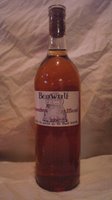
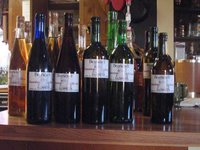 After bottling the wine, we moved on to bottling the Sassafras Mead. As with our last batch, this mead has exquisite color and clarity. Unlike the last batch, this one is almost drinkable already. It still has a bit of a jet fuel aftertaste, though, so it will get to lay in a wine rack for a year or so before we serve it to anyone. If past experience is any guide, this will be an excellent mead in a few years.
After bottling the wine, we moved on to bottling the Sassafras Mead. As with our last batch, this mead has exquisite color and clarity. Unlike the last batch, this one is almost drinkable already. It still has a bit of a jet fuel aftertaste, though, so it will get to lay in a wine rack for a year or so before we serve it to anyone. If past experience is any guide, this will be an excellent mead in a few years.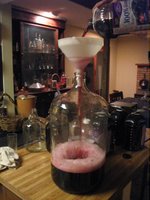 Our final project of the day was to start a brand new batch of Concord Wine. We've made this wine before as a sparkling wine that carbonates in the bottle (and won a blue ribbon in the sparkling division at the Tennessee Viticultural & Oenological Society wine contest, I might add). We'll be using slightly easier methods this time; this will be a sweet, still wine that we'll "bottle" in a cornelius keg and then pressurize. Our objective is to have it ready in time for Gulf Wars XVI.
Our final project of the day was to start a brand new batch of Concord Wine. We've made this wine before as a sparkling wine that carbonates in the bottle (and won a blue ribbon in the sparkling division at the Tennessee Viticultural & Oenological Society wine contest, I might add). We'll be using slightly easier methods this time; this will be a sweet, still wine that we'll "bottle" in a cornelius keg and then pressurize. Our objective is to have it ready in time for Gulf Wars XVI.This batch of wine started with common Concord grape juice that you can find at any grocery. Having more presence of mind than usual, I remembered to take hydrometer readings of the juice before starting fermentation. Our juice had a specific gravity of 1.065, which is sweet enough to carry the wine to about 8% alcohol after fermentation. That's not enough; the wine wouldn't be strong enough to keep vinegar bacteria from establishing themselves. We therefore needed to add some sugar.
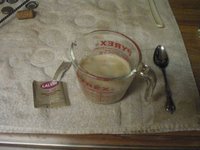 This operation involved dumping five pounds of sugar into an empty grapejuice bottle, pouring about half a bottle of juice in after, and then shaking vigorously to mix the sugar into the juice. We then poured the mixture into the carboy. This little operation brought the specific gravity up to 1.100, which should make a wine with about 13% alcohol.
This operation involved dumping five pounds of sugar into an empty grapejuice bottle, pouring about half a bottle of juice in after, and then shaking vigorously to mix the sugar into the juice. We then poured the mixture into the carboy. This little operation brought the specific gravity up to 1.100, which should make a wine with about 13% alcohol.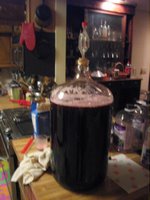 After proofing some Lalvin 71B-1122 wine yeast (saccharomyces cerevisiae), we added it to the carboy, and we saw the first signs of fermentation within the hour. The wine can sit quietly in a corner for a few weeks while it goes through its primary fermentation. After that, it should slow down enough for its first racking.
After proofing some Lalvin 71B-1122 wine yeast (saccharomyces cerevisiae), we added it to the carboy, and we saw the first signs of fermentation within the hour. The wine can sit quietly in a corner for a few weeks while it goes through its primary fermentation. After that, it should slow down enough for its first racking.I shall try to remember to document the entire procedure here at the Saga.



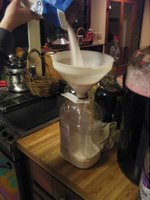
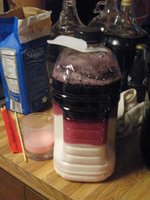
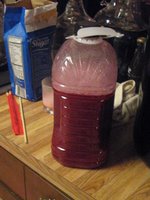

No comments:
Post a Comment